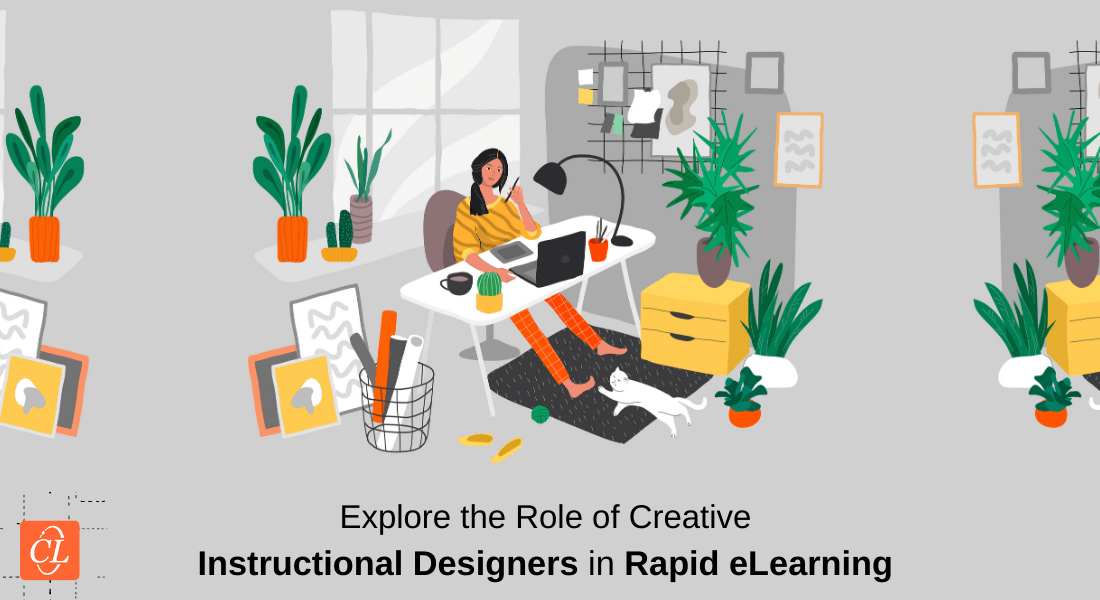Rapid eLearning: 3 Key Responsibilities of an Instructional Designer

Instructional designers play an important role in creating and delivering training material to eLearners. But their role goes much further when it comes to rapid eLearning development. They are responsible for analyzing the needs of the learners and developing systematic learning experiences. The instructional designers usually focus on the problem-solving aspect of the eLearning design.
Wondering How an Instructional Designer Contributes to Rapid eLearning Development?
Here are their key responsibilities:
- Understanding the Requirements
- Focus on the Design and Structure
- Implement and Build an Engaging Rapid eLearning Module
They have a key part in the entire development and how they carry out their job responsibilities decides the success of the initiative. So let us discuss each of their responsibility in detail, but before that, let us understand more about instructional design.
What is Instructional Design?
Instructional Design (ID) can be defined as the practice of developing effective learning experiences to help with training. The approach involves analyzing, designing and developing, executing, and assessing the instructional experience.
Instructional designers are paramount in rapid eLearning development. They are responsible for redesigning existing courses, creating new curriculums or courses, and developing training materials, such as learner guides and instructor manuals. And to fulfill these responsibilities, the instructional designers apply the best ID practices and strategies, and come up with practical and systematic solutions.
In order to fulfill these requirements, the instructional designer need to have certain qualities including –
Have sharp research and analytical skills that will help them get a better understanding of what the learners need and what the organization expects. For understanding the learners, the instructional designers have to work closely with them, understand the challenges they face and then think of ways to use training to help the learners perform better.
The instructional designers are required to have complete knowledge of authoring tools and should be skilled enough to use the tools’ capabilities to develop impactful rapid eLearning courses.
Have a thorough understanding of industry trends and ID best practices and they must think of creative ways to apply these practices to make the rapid eLearning solution more creative.
Master instructional designing with this course designed by Dr. Howard Lewis
Other than these skills, the instructional designers should also have soft skills such as communication, creativity and time management to ensure that they conduct their job in the most effective way.
Now, you have a proper understanding of the qualities that instructional designers need to have in order to handle a successful rapid eLearning development project. Let us now try to understand their responsibilities in detail –
3 Key Responsibilities of an Instructional Designer
1. Understanding the Requirements
Before embarking on the journey to rapid eLearning course development, an instructional designer has to work on the ground level – they need to get a proper understanding of the eLearners. for this, the instructional designer (ID) has to analyze the learners, the skills they already have, and their knowledge and attitude gaps. Once this is done, they will have to match all of them the organization’s aims and expectations from the training imparted to the employees.
To fulfill this, the ID works along with the Subject Matter Expert (SME) to ensure that the content is factually correct and meets the requirements of the eLearning course. Based on all this, the ID will be able to plan the best possible way to organize it, and decide on the most appropriate instructional strategy to deliver the best eLearning course. At this stage, it helps a lot if the ID is aware of the latest trends in the Learning and Development (L&D) and eLearning industry. It will help them plan it right.
2. Focus on the Design and Structure
Once the ID gets a clear understanding of the learners’ requirements and the expectations from the rapid eLearning course to be developed, he/she dons the hat of an eLearning designer. They are responsible for taking care of the design and structure of the online training module being developed.
They have to focus on the structure and fluidity of the content and emphasize organizing the training content in an organized, sequential, and smooth flow.
P.S. Remember that no matter how high the quality of the content is, it will all go in vain if the flow is not right.
The designer has to ensure that the content remains relevant, fun, and engaging while also ensuring that it does not lose its context.
3. Implement and Build an Engaging Rapid eLearning Module
This is definitely the biggest responsibility of the ID. The professional, using rapid eLearning authoring tools to handle the eLearning development. In order to ensure that the rapid eLearning solution is engaging and keeps the employees hooked, the instructional designer has to include multimedia assets such as audio, video, GIFs, etc. the designer can also include gamification or other eLearning interactivities to make the content more engaging.
Parting Thoughts
Instructional designers play a crucial role in rapid eLearning development. They contribute to the process right from the start and remain a key part even at the time of delivery. Considering the high-level responsibilities that they have; instructional designers need to have detailed understanding of the latest trends and the updates in the industry of operation.
And as we are just starting on the new year, I feel that you (and your L&D team including the instructional designers) could find this “eLearning Trends 2023: A View from the Trenches” helpful.





